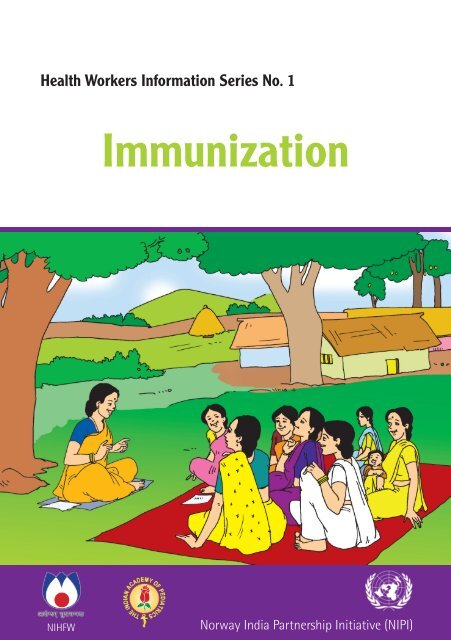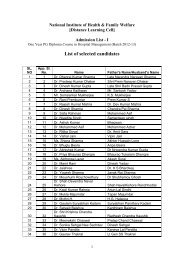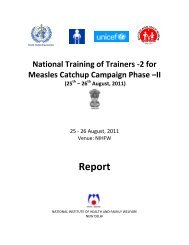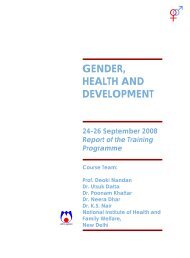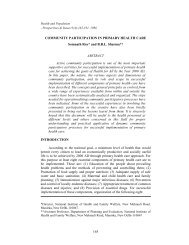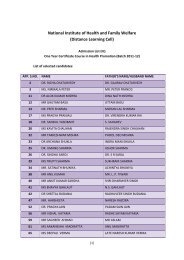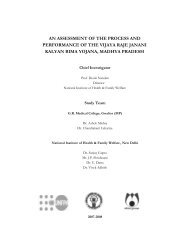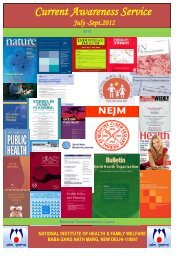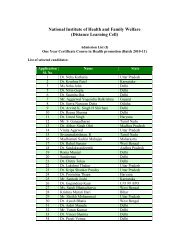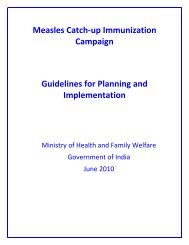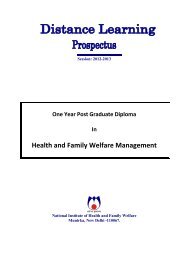Health Workers Information Series No. 1 - National Institute of health ...
Health Workers Information Series No. 1 - National Institute of health ...
Health Workers Information Series No. 1 - National Institute of health ...
You also want an ePaper? Increase the reach of your titles
YUMPU automatically turns print PDFs into web optimized ePapers that Google loves.
<strong>Health</strong> <strong>Workers</strong> <strong>Information</strong> <strong>Series</strong> <strong>No</strong>. 1<br />
NIHFW<br />
Immunization<br />
<strong>No</strong>rway 1 India Partnership Initiative (NIPI)
Acknowledgements<br />
This handout has been prepared by <strong>National</strong> Child <strong>Health</strong><br />
Resource Centre (NCHRC) <strong>of</strong> <strong>National</strong> <strong>Institute</strong> <strong>of</strong> <strong>Health</strong> and<br />
Family Welfare (NIHFW) for use by the frontline workers. The<br />
information presented in the handout is largely drawn from<br />
the Immunization Handbook for Medical Officers published<br />
by Department <strong>of</strong> <strong>Health</strong> and Family Welfare, Government<br />
<strong>of</strong> India. We gratefully acknowledge the support provided<br />
by Indian Academy <strong>of</strong> Paediatrics (IAP) for technical review<br />
<strong>of</strong> the material. We also thank NIPI – UNOPS for evolving<br />
the idea to develop this resourse material and for providing<br />
financial support for the initiative.<br />
2
Immunization<br />
Measles (Subcutaneous)<br />
Hepatitis B (Intramuscular)<br />
OPV (Oral)<br />
1. When do we call a child fully Immunized?<br />
A child is considered fully immunized, when he/she has<br />
received one dose <strong>of</strong> BCG, three doses <strong>of</strong> DPT and OPV each<br />
and one dose <strong>of</strong> measles by the age <strong>of</strong> 12 months.<br />
2. In our country how many children have received full<br />
immunization?<br />
Periodic surveys conducted by Govt. <strong>of</strong> India namely <strong>National</strong><br />
Family <strong>Health</strong> Survey (NFHS) and District Level Household<br />
Survey (DLHS) provide us with accurate information on<br />
immunization status <strong>of</strong> children. According to the NFHS-<br />
3 (2005-06), less than half (43.5%) <strong>of</strong> the children in the<br />
age group 12-23 months are fully immunized. Immunization<br />
coverage rates varies among different states: they are higher<br />
among several southern states such as Kerala, Tamil Nadu<br />
etc. and are lower in central/northern India including Madhya<br />
Pradesh, Rajasthan, Uttar Pradesh, Bihar and Orissa.<br />
3<br />
Vitamin A (Oral)<br />
BCG (Intradermal)<br />
DPT (Intramuscular)
3. Why is BCG vaccine given on the left upper<br />
arm only?<br />
BCG is given on the left upper arm to maintain<br />
uniformity and for helping surveyors in verifying<br />
the receipt <strong>of</strong> the vaccine (by checking the presence<br />
<strong>of</strong> a scar on the left upper arm).<br />
4. Why do we give a lower dose (0.05 ml) <strong>of</strong><br />
BCG to neonates below 1 month <strong>of</strong> age?<br />
This is because the skin <strong>of</strong> newborns is thin and an<br />
intradermal injection <strong>of</strong> 0.1ml may penetrate into<br />
the deeper tissue and may cause local abscess and<br />
enlarged axillary lymph nodes.<br />
5. If BCG vaccine is not given at birth, when<br />
should it be given?<br />
If not given at birth or along with DPT-1, then it<br />
should be given as early as possible. BCG can be given any<br />
time before 1 year <strong>of</strong> age.<br />
6. Why is BCG given only up to 1 year <strong>of</strong> age?<br />
This is because most children acquire natural clinical/<br />
sub-clinical tuberculosis infection by the age <strong>of</strong> 1 year.<br />
This too protects against severe forms <strong>of</strong> childhood<br />
tuberculosis.<br />
7. If no scar appears after administering BCG, should one revaccinate<br />
the child?<br />
There is no need to revaccinate the child if there is no scar.<br />
8. Why should DPT vaccine be given in the antero-lateral mid<br />
thigh and not the gluteal region (buttocks)?<br />
DPT is given in the antero-lateral mid thigh and not the<br />
gluteal region to prevent damage to the sciatic nerve. In<br />
4
addition, the vaccine deposited in the fat <strong>of</strong> gluteal region<br />
does not invoke the appropriate immune response.<br />
9. Why should there be a minimum gap <strong>of</strong> 4 weeks between<br />
2 doses <strong>of</strong> DPT?<br />
This is because decreasing the interval between two doses<br />
may interfere with the antibody response and protection<br />
against the diseases.<br />
10. What should one do if a child is found allergic to DPT or<br />
develops encephalopathy after DPT?<br />
If a child is allergic or develops encephalopathy after DPT,<br />
he/she should be taken to a doctor immediately. Also the child<br />
should be given DT vaccine during the subsequent dose as it<br />
is usually the P (Pertussis) component <strong>of</strong> the vaccine which<br />
causes the allergy/encephalopathy.<br />
11. If a child has received DPT-1 but comes late for receiving<br />
DPT-2, should one restart with the fi rst dose<br />
<strong>of</strong> the vaccine?<br />
Do not start the schedule all over again<br />
even if the child is brought late for a dose.<br />
Pick up where the schedule was left <strong>of</strong>f.<br />
For example: if a child has received BCG,<br />
DPT-1 and OPV-1 at 5 months <strong>of</strong> age and<br />
returns at 11 months <strong>of</strong> age, vaccinate the<br />
child with DPT-2, OPV-2 and Measles and<br />
do not start from DPT-1 again.<br />
12. If a child could not receive DPT 1, 2, 3 and<br />
OPV 1, 2, 3 as per the schedule, till what<br />
age can these vaccines be given?<br />
DPT vaccine can be given till 2 years <strong>of</strong> age<br />
and OPV can be given till 5 years <strong>of</strong> age.<br />
5
13. If not given at birth, when should OPV-0 be given?<br />
OPV-0 dose can be given up to 15 days after birth.<br />
14. Can an infant be breast fed immediately after OPV?<br />
Yes<br />
15. A child has received 3 doses <strong>of</strong> OPV as per<br />
the immunization schedule. Should this child<br />
still be given a dose <strong>of</strong> OPV during the Pulse<br />
Polio Campaign?<br />
All children upto the age <strong>of</strong> 5 years should be<br />
given a dose <strong>of</strong> polio vaccine during the pulse<br />
polio campaign, even when they have need<br />
all the doses <strong>of</strong> OPV as per the immunization<br />
schedule.<br />
16. When can measles vaccine be given if the<br />
child has not received this between 9-12<br />
months <strong>of</strong> age as per schedule?<br />
A single dose <strong>of</strong> measles vaccine can be given till 5 years<br />
<strong>of</strong> age if the child has not received the vaccine during 9-12<br />
months <strong>of</strong> age as per the schedule.<br />
17. Why should Measles vaccine be given on the right upper arm<br />
only?<br />
Measles vaccine is given on the right upper arm to maintain<br />
uniformity and to help surveyors in verifying the receipt <strong>of</strong> the<br />
vaccine.<br />
18. If a child has received the Measles vaccine before 9 months <strong>of</strong><br />
age, is it necessary to repeat the vaccine later?<br />
Yes, the Measles vaccine should be repeated even if a child<br />
has received it before the recommended age.<br />
6
19. Until what age can Hepatitis B vaccine be given?<br />
According to the <strong>National</strong> Immunization Schedule, Hepatitis<br />
B vaccine should be given with the first, second and third<br />
doses <strong>of</strong> DPT till 1 year <strong>of</strong> age.<br />
20. Can Hepatitis B vaccine be mixed in the same syringe with<br />
DPT and given as one injection?<br />
<strong>No</strong>, DPT and Hepatitis B vaccine (if supplied<br />
separately) cannot be mixed or administered<br />
through the same syringe.<br />
21. If a girl received all doses <strong>of</strong> DPT, and TT as<br />
per the <strong>National</strong> Immunization Schedule till<br />
16 years <strong>of</strong> age and she gets pregnant at 18<br />
years, should she get one dose <strong>of</strong> TT during<br />
pregnancy?<br />
Give 2 doses <strong>of</strong> TT during the pregnancy as per<br />
the schedule.<br />
22. Why is it not advisable to clean the injection site with a<br />
spirit swab before vaccination?<br />
This is because some <strong>of</strong> the live components <strong>of</strong> the vaccine<br />
are killed if they come in contact with spirit.<br />
23. If a child who has never been vaccinated is brought for<br />
Immunization at 9 months <strong>of</strong> age, can all the due vaccines<br />
be given to him/her on the same day?<br />
Yes, all the due vaccines can be given during the same<br />
session but at different injection sites using separate<br />
AD syringes. It is safe and effective to give BCG, DPT,<br />
Hepatitis B, OPV and Measles vaccines and Vitamin A at<br />
the same time to a 9 months old child who has never<br />
been vaccinated.<br />
7
1,00,000/- IU 2,00,000/- IU<br />
24. If the mother/caregiver permits administration <strong>of</strong> only one<br />
injection to a child who has come for Immunization at 9<br />
months <strong>of</strong> age, which vaccine should be given?<br />
At 9 months <strong>of</strong> age, the priority is to give measles vaccine<br />
with OPV and Vitamin-A.<br />
25. Which vaccines can be given to a child between 1-2 years <strong>of</strong><br />
age, who has never been vaccinated?<br />
The child should be given DPT-1, OPV-1, Measles and 2ml <strong>of</strong><br />
Vitamin A solution. He/ she should then be given the second<br />
and third doses <strong>of</strong> DPT and OPV at one month intervals till<br />
2 years <strong>of</strong> age. The booster dose can be given at a minimum<br />
interval <strong>of</strong> 6 months after administering OPV-3/ DPT-3.<br />
26. If a child comes between the age <strong>of</strong> 2 to 5 years without<br />
having received any vaccine, what vaccines should be given?<br />
The child should be given two doses <strong>of</strong> DT with OPV with<br />
a minimum gap <strong>of</strong> 4 weeks ( or 1 month). A single dose <strong>of</strong><br />
measles vaccine also needs to be given with the fi rst dose<br />
<strong>of</strong> DT.<br />
27. What vaccines should one give to a child who is brought after<br />
6 years <strong>of</strong> age for the fi rst time?<br />
Give the child only 2 doses <strong>of</strong> TT one month apart.<br />
28. How should Vitamin A syrup be administered?<br />
Vitamin A syrup should be administered using only the spoon/<br />
dispenser provided with each bottle. The half mark in the<br />
spoon indicates 1,00,000/- IU and a level full spool contains<br />
2,00,000/- IU <strong>of</strong> Vitamin A. A child less than 1 year <strong>of</strong> age<br />
should be given 1 ml, and a child older than 1 year should be<br />
given 2 ml <strong>of</strong> vitamin A.<br />
8
29. What should be the minimum gap between two<br />
doses <strong>of</strong> Vitamin A?<br />
The minimum gap between any two doses <strong>of</strong><br />
vitamin A should be 6 months.<br />
30. What are the storage guidelines for un-opened<br />
bottles <strong>of</strong> Vitamin A solution?<br />
Vitamin A solution must be kept away from direct<br />
sunlight.<br />
31. How long can a bottle <strong>of</strong> Vitamin A be used, once<br />
opened?<br />
Vitamin A bottle, once opened, should be used<br />
within 6-8 weeks. Write the date <strong>of</strong> opening on<br />
the bottle.<br />
9
<strong>No</strong>tes<br />
10
<strong>No</strong>tes<br />
11
vkjksX;e~ lq[klEink<br />
<strong>National</strong> Child <strong>Health</strong> Resource Centre<br />
<strong>National</strong> <strong>Institute</strong> <strong>of</strong> <strong>Health</strong> and Family Welfare<br />
Baba Gang Nath Marg, Munirka, New Delhi-110067<br />
Phones: 26165959/26166441/26188485/26107773<br />
Fax: 91-1126101623<br />
Website: www.nihfw.org<br />
ii


